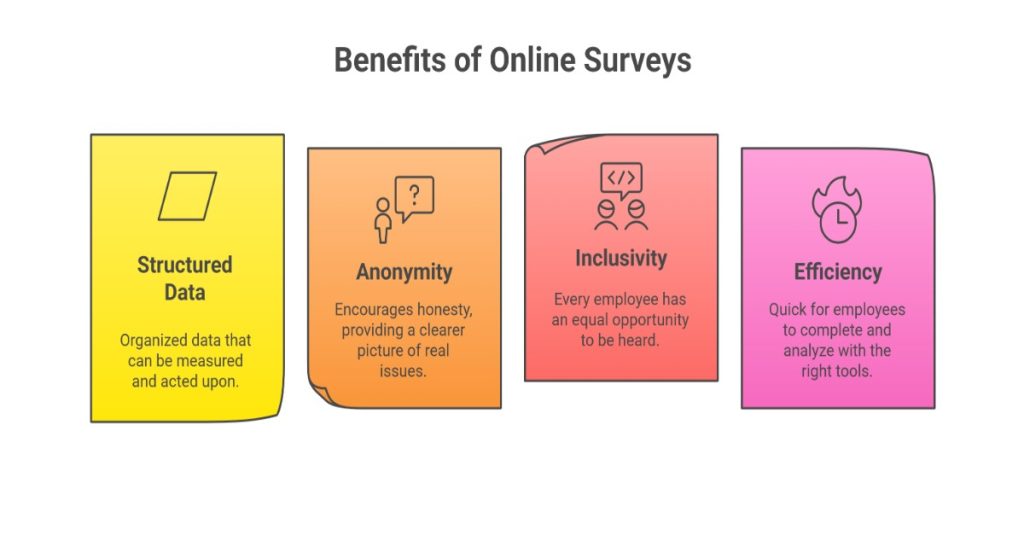Let’s be honest. Company communication is tough. You send out emails, hold town halls, and put up posters, but sometimes it feels like you’re speaking into a void. Are your employees truly engaged? Do they feel heard? More importantly, do you have a clear, honest picture of what they are thinking and feeling?
This communication gap is a major pain point for many organizations. It leads to low morale, high turnover, and missed opportunities for growth. You know something needs to change, but the traditional suggestion box feels outdated, and organizing face to face meetings with everyone is impractical.
What if there was a straightforward, effective way to bridge this gap? A method that gives every employee a voice, provides you with real data, and builds a stronger, more connected workplace.
The answer lies in implementing online surveys for employee feedback. This blog will walk you through why this method works and how you can set up a system that gets results, improves communication, and makes your employees feel truly valued.
Table of Contents
Why Your Current Feedback System Might Be Failing?
Before we build a new system, it’s helpful to understand why old methods often fall short.
The Silent Meeting Syndrome: In meetings, only the most vocal employees speak up. Many stay quiet, either from shyness, a fear of contradicting their manager, or a sense that it won’t make a difference. You only hear from a small fraction of your team.
The One-Way Street of Email: Email is great for broadcasting information, but it’s terrible for gathering it. You have no structured way to collect, measure, or analyze responses. Feedback gets lost in crowded inboxes.
The Anonymous Fear Factor: While an anonymous suggestion box aims to encourage honesty, it offers no follow up. You can’t ask clarifying questions or let the employee know their idea was implemented. This can make people feel their input disappears into a black hole.
These methods often result in a workforce that feels disconnected. Employees who don’t feel heard are less likely to be engaged, and disengagement is a direct path to decreased productivity and increased staff turnover.

The Power of the Pulse: How Online Surveys Change the Game?
Online surveys offer a modern solution to these old problems. They are not just digital questionnaires; they are a powerful communication tool when used correctly.
Think of them as a regular “pulse check” on the health of your organization. Instead of guessing how your team feels, you can ask them directly in a way that is:
Structured: You get organized data that you can actually measure and act upon.
Anonymous (When Needed): This encourages brutal honesty, giving you a clearer picture of real issues.
Inclusive: Every single employee, from the front line to the top floor, has an equal opportunity to be heard.
Efficient: They take little time for employees to complete and even less time for you to analyze with the right tools.
By making feedback a regular, structured, and respected part of your culture, you show your team that their opinions are not just welcome; they are essential to the company’s success.

Getting Started: Designing Surveys That People Actually Want to Take
A poorly designed survey can do more harm than good. If it’s too long, confusing, or feels like a waste of time, it will frustrate your employees. Here’s how to design surveys that get a high response rate and valuable insights.
1. Define Your Clear Goal
What do you want to learn? A vague goal like “see how everyone is doing” will lead to a vague survey. Be specific.
Bad Goal: Check employee satisfaction.
Good Goal: Measure satisfaction with the new project management software introduced last quarter.
Good Goal: Gauge team sentiment on work life balance after the recent busy season.
Your goal dictates every question you ask.
2. Keep It Short and Focused
Respect your employees’ time. A “pulse survey” should take no more than 3 to 5 minutes to complete. This means asking 5 to 10 targeted questions. Long, exhausting surveys lead to “survey fatigue,” where people either abandon it halfway through or rush through without thinking.

3. Ask the Right Kinds of Questions
Mix up your question types to get both quantitative (numerical) and qualitative (descriptive) data.
Quantitative Questions (The Numbers):
Likert Scale: “On a scale of 1 to 5, how strongly do you agree with this statement: ‘I receive clear communication from my manager.'”
Multiple Choice: These are great for quick, categorical answers.
These questions give you easy to graph data that shows trends over time.
Qualitative Questions (The Stories):
Open Ended Text Boxes: “What is one thing we could do to improve our team meetings?”
These questions provide the “why” behind the numbers and often contain the most valuable, unexpected insights.
4. Guarantee and Communicate Anonymity
For honest feedback on sensitive topics, anonymity is non-negotiable. Use a survey platform that does not track individual responses. Most importantly, you must clearly communicate this to your employees. If they don’t trust that their responses are anonymous, they will not be honest.
From Data to Action: The Most Important Step
This is the part where most companies fail, and it is the single biggest reason feedback initiatives die. Collecting data is pointless if nothing changes.
1. Analyze the Results Objectively
Look at the data without defensiveness. This is not a personal attack; it’s a diagnostic tool. What are the main trends? What are the biggest areas of satisfaction and dissatisfaction? Look for comments that are repeated by multiple people; these are your priority areas.
2. Share the Findings with Everyone
Transparency is key to building trust. Share a summary of the survey results with the entire company. This does two things: it shows you actually read the responses, and it makes the issues a shared challenge, not a secret management problem.

3. Create an Action Plan
Based on the feedback, create a simple, clear plan. What is the key issue you will address? What are the specific steps you will take? Who is responsible? What is the timeline?
For example: “In the survey, 70% of you said you wanted more professional development. Our action plan is to introduce a quarterly training workshop. Sarah from HR will coordinate, and the first session will be scheduled for next quarter.”
4. Close the Loop
This is critical. After you have shared the results and the action plan, you must follow up. A few months later, report on the progress. “Remember the survey where you asked for better coffee? We’ve switched providers. Thank you for the feedback!” This “closing the loop” proves that the survey was not just a corporate exercise. It builds credibility and ensures employees will be more likely to participate in the future.
Building a Culture of Continuous Feedback
Online surveys should not be a once a year event. The goal is to create a culture of ongoing communication.
Schedule Regular Pulse Checks: Send out short, focused surveys every month or quarter to track sentiment and catch issues early.
Use Different Surveys for Different Needs:
Onboarding Surveys: Get feedback from new hires after their first 30 days.
Exit Interviews: Understand why people are leaving.
Project Post Mortems: Learn what went well and what can be improved after a major project.
Encourage Two Way Dialogue: Let employees know that surveys are just one part of the conversation, not a replacement for it.
Read More
Machine Learning for Customer Review Analysis: From Data to Deployment
The Ultimate Guide to Survey Design for 2025
Eliminate Common Survey Errors: A Simple Guide
Conclusion: Your First Step Towards a More Connected Workplace
Improving communication is not about finding a magic bullet. It is about building consistent, reliable channels for listening. Online employee surveys provide one of the most effective channels available.
They replace guesswork with data, silence with insight, and frustration with a clear path forward. By asking the right questions, listening without judgment, and taking visible action, you can transform employee feedback from a dreaded chore into your most powerful tool for building a positive, productive, and loyal team.
The journey to better communication starts with a single question. What will you ask your team first?

